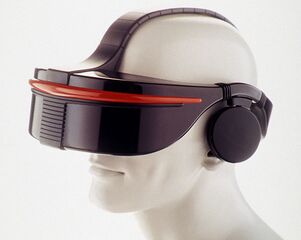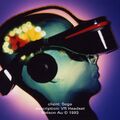Difference between revisions of "Sega VR"
From Sega Retro
| Line 1: | Line 1: | ||
| − | + | {{ConsoleBob | |
| + | | logos= | ||
| + | | consoleimage=Segavr physical01.jpg | ||
| + | | maker=[[Sega]] | ||
| + | }} | ||
| + | |||
[[Sega]], flush with funds from the Sega [[Mega Drive]], announced the '''Sega VR''' add-on in 1991. It was based on an IDEO [[virtual reality]] headset (HMD) with [[Liquid crystal display|LCD]] screens in the visor and stereo headphones. Inertial sensors in the headset allowed the system to track and react to the movements of the user's head. | [[Sega]], flush with funds from the Sega [[Mega Drive]], announced the '''Sega VR''' add-on in 1991. It was based on an IDEO [[virtual reality]] headset (HMD) with [[Liquid crystal display|LCD]] screens in the visor and stereo headphones. Inertial sensors in the headset allowed the system to track and react to the movements of the user's head. | ||
| Line 30: | Line 35: | ||
==Videos== | ==Videos== | ||
<mediaplayer playlist="right" playlistsize="300" width="670" repeat="list" playlistfile>File:Segavr videos.xml</mediaplayer> | <mediaplayer playlist="right" playlistsize="300" width="670" repeat="list" playlistfile>File:Segavr videos.xml</mediaplayer> | ||
| − | |||
==Gallery== | ==Gallery== | ||
| Line 39: | Line 43: | ||
==Magazine articles== | ==Magazine articles== | ||
{{mainArticle|{{PAGENAME}}/Magazine articles}} | {{mainArticle|{{PAGENAME}}/Magazine articles}} | ||
| + | |||
| + | ==References== | ||
| + | <references /> | ||
[[Category:Sega VR| ]] | [[Category:Sega VR| ]] | ||
[[Category:Hardware]] | [[Category:Hardware]] | ||
Revision as of 10:28, 11 June 2016

|
| Sega VR |
|---|
| Manufacturer: Sega |
Sega, flush with funds from the Sega Mega Drive, announced the Sega VR add-on in 1991. It was based on an IDEO virtual reality headset (HMD) with LCD screens in the visor and stereo headphones. Inertial sensors in the headset allowed the system to track and react to the movements of the user's head.
It was the first VR headset to track head movement, some two decades before the Oculus Rift. The arcade version, Sega VR-1, was released in 1994, but planned versions for the Mega Drive, and then the Saturn, were cancelled.
Contents
Arcades
In 1994, the technology was utilized for the Sega VR-1 motion simulator arcade attraction,[1] which was available at SegaWorld arcades. It was able to, fairly accurately, track head movement, and featured 3D polygon graphics in stereoscopic 3D. It was a large networked attraction designed for multiple players, like Galaxian 3 (1990).
A more scaled-down arcade version, Dennoo Senki Net Merc, was demonstrated at Japan's 1995 AOU (Amusement Operators Union) show, and it used the Sega Model 1 board to produce the game's 3D graphics. The game was not so well-received, with the flat-shaded graphics being compared unfavourably to the Sega Model 2's textured-filtered graphics.[2]
Consoles
Because of development difficulties the Mega Drive version of the Sega VR remained only a prototype. It was last seen at computer shows in 1993 and vanished from the release schedules in 1994. Four games were apparently developed for the system, each using 16 Mb cartridges that were to be bundled with the headset: Nuclear Rush, Iron Hammer, Matrix Runner and Outlaw Racing.
In addition, a port of the hit arcade racer Virtua Racing was also planned for the Sega VR.[3]
The company claimed the project was stopped because the VR was so real users would move while wearing the headset and injure themselves. The limited processing power of the system makes this claim unlikely, although there were reports of testers developing headaches and motion sickness. Mark Pesce, who worked on the Sega VR project, says the Stanford Research Institute warned Sega of the 'hazards' of prolonged use. [1]
Sega went on to other VR projects for use in arcades and a similar add-on was reported but never seen for the Sega Saturn. The project encouraged a brief flurry of other companies to offer VR products.
Sega VR in Popular Culture
Despite never receiving an official release, the Sega VR was featured in the Spike Lee movie "Clockers" (with a game called "Gangsta") and promotional material for the system had been created, leading to speculation that working units were produced before the system was discontinued. The Sega VR can be seen in a 1992 American commercial for Alpha-Bits cereal.
Legacy
Due to the interest in virtual reality technology at the time, Sega's development of the headset sparked a flurry of activity, along similar lines, among the company's competitors in the early-mid-1990's, but no other completed device had ever sold well.
Sega's chief competitor, Nintendo, would go on to release the ill-fated Virtual Boy in 1995, in an attempt to beat Sega's anticipated VR device to the market. Nintendo's table-top device brought discomfort after extended play, and lacked certain features of the Sega VR (such as colour 3D graphics and head-tracking). The Virtual Boy is regarded as one of Nintendo's worst commercial failures, and is considered to be partly responsible for the eventual demise of VR technology later in the 1990's.
The concept of head-tracking VR would not be be revisited again until the rise of motion controls in the 21st century. In 2012, Sega's concept of a head-tracking VR headset was eventually revived by the Oculus Rift. Its developer Oculus VR mentioned Sega's headset as an influence that they wanted to improve on. In turn, the Oculus Rift has inspired similar VR devices from Sony (Project Morpheus), Valve, and Microsoft, in 2014, sparking a revival of VR technology, which eventually led to Facebook's $2 billion purchase of Oculus VR in an attempt to introduce this technology to a wider audience beyond gaming.
Videos
<mediaplayer playlist="right" playlistsize="300" width="670" repeat="list" playlistfile>File:Segavr videos.xml</mediaplayer>
Gallery
Magazine articles
- Main article: Sega VR/Magazine articles.
References
- ↑ http://arcadeheroes.com/2013/06/06/segas-wonderful-simulation-games-over-the-years/
- ↑ https://archive.org/stream/nextgen-issue-006/Next_Generation_Issue_006_June_1995#page/n23/mode/2up/search/vr-1
- ↑ [Electronic Gaming Monthly, Video Game Preview Guide, 1993 Electronic Gaming Monthly, Video Game Preview Guide, 1993]
